Biography
Interests
Naisberg, Y.
Freelance, Haifa, Israel
*Correspondence to: Dr. Naisberg, Y., Freelance, Haifa, Israel.
Copyright © 2021 Dr. Naisberg, Y. This is an open access article distributed under the Creative Commons Attribution License, which permits unrestricted use, distribution, and reproduction in any medium, provided the original work is properly cited.
Abstract
The old art states that the purine and pyrimidine bases of DNA contain genetic information groups for synchronizing or correcting navigation of cells and stages of body growth / but not on scenarios of continuous life events affecting external DNA information to regulate longevity formation.
The new art states that the circadian/annual chronology cycles on earth activate phosphate groups to synchronize or correct navigate a) cells & body growth\development stages and b) on deoxyribose the negative feedback encoding for day-to-night body operating ranges (BOR) with activating and deactivating in the Watson-Crick double helix proper spirals:
I. Phosphate group spirals copying after solar circadian chronology to synchronize all chromosomal biochemical units alike in the double helix.
Ia. Phosphate group spirals to encode in nm spiral widths accountable for circadian and annual changes in the double helix copying the day-to-night elongation for life span.
II. Deoxyribose sugar spirals with pits and heights binary encoding of negative feedback mechanisms to synchronize from afresh at:
IIa. Sleep automatic stage IV to keep an ongoing cellular size and homeostasis.
IIb. REM sleep the sex organs to optimize at day best pair selections for species survival.
IIc. Wakefulness the body operating ranges (BOR) to meet adaptation and survival demands.
IId. The structural build-up of new sensory (mental) webs due to new systematic learning. Such
mental webs are imprint on mature gametes to improve Human Intelligence in posterity.
All these biophysical genetic markers may identify healthy and abnormal states.
Article Construction
Part 1: Introduction (background) describes the double helix the old art point of view.
Part 2: Definition.
Part 3. Scientific Facts on the Double Helix.
Part 4: The Biophysical origin of the double helix.
Part 5: Scientific Grounds Confirming the Presence of Biophysical Encoding.
Part 6: Modeling Biophysical Encoding.
Part 7. Nano Technology to Practice Detection of Biophysical Markers.
Part 8: Conclusion.
Part 9. References.
Introduction
This article highlights the application of biophysical heredity encoding to develop proper technology to
mark and to improve the Health care delivery. The aim is to bring scientific prove to show in which way
biophysical neurophysiological navigation is encoded to keep a) chronological maturation, b) homeostatic
harmony and c) intelligent promotion in the human brain.
DNA is the blueprint of life by using the codes to accommodate the build-up of structural and enzymatic
proteins for all cells in the organism [1,2]. There are 23 diploid pairs of chromosomes (DNA) to be coiled
and condensed in packages to constitute the karyotype of an individual [3,4]. Three known techniques help
to categorize the essential normal biophysical neurophysiological properties of chromosomes [5,6].
1. Chromosomal size arrangement in a karyotype from the biggest to the smaller.
2. Chromosomal shape arrangement in a karyotype from the position of the centromere to hold two arms of chromosomes together.
3. Chromosomal identification by their banding patterns after being stained with trypsin-Giemsa to a G-banded pattern or with alike patterns marked with other techniques. For these hereditary interconnected paradigms are of the outmost importance:
a) anatomic differentiation due to various cellular chromosomal structures,
b) neurophysiological negative feedback programs running unique operations, and
c) solar timing that regulates this anatomical growth and development tuned with biophysical physiological
internal homeostasis matching life events for any unit of time from fertilization via birth, through all
maturation stages to end of life. A genome map in per se cannot be fully accountable for such types of
regulation based on identical chronological synchronizing properties across all chromosomes [7,8]. Even
if all the chromosomes are linearly arranged one after the other, they can stretch to a length of about two
meters, carrying in total the complete organism information [9,10].
Since the ultimate goal of chromosomes is to provide the comprehensive information, it seems likely that the phosphate groups in conjunction with the deoxyribose sugar strands on the DNA backbone perform in addition to structural function, external information encoding as well [11,12]. Because external information has coding markers, it is likely that repeated sequences of several phosphate and deoxyribose sugar groups of the spinal cord of DNA spirals on a twisted scale may hold the missing regulatory markers inherited together as a biophysical mapping of the overall mental neuronal networks [13,14].
On the chronological map, nanometer distances between two neighboring spirals some portions on them will always face the same ‘day-night-profile’ to be restrict within bottom-to-top margins. These limitations must be accountable for chronological transmission accuracy guiding the growth & development of the organism from birth to old age. Thus, timing is a crucial ingredient responsible for inherited features of agebased chronology regulating the human genome’s with around 3 billion nucleotides, with computer-like algorithms having a 3 GB hardware structure [15,16].
Definition
Biophysical neurophysiological contextual encoding presents a unique mode of regulation (navigation) of a)
chronological quantity-based composition of biochemical elements across all cells at all maturation stages.
Multiple negative feedback mechanisms following solar system’s regulation to govern 1 to 4 nocturnal and
5 to 8 diurnal stages body operational ranges (BOR) to match environmental demands within homeostatic
frames of reference.
b) building-up imprinting of novel Mental webs that were developed via new kinds of systematic learning to be placed on mature gametes and to be inherit by the next generation to improv e the overall Mental neuronal networks to optimize new learning creativity, adaptation and survival. These biophysical properties have been attributed to and linked with predefined physical spaces on the DNA backbone (sequencebased phosphate groups and deoxyribose sugar spirals) having physical imprinted templates on all spirals to respond and chronologically only to proper age-related rhythms by an activated number of spirals in current resynchronization of cells and keeping prospective spirals in deactivated conditions. Thus, the aim of this article is to present scientific evidence for these basic biophysical neurophysiological encoding elements to be in description on further pages.
Scientific Facts on the Double Helix
By learning these elementary facts about the human body organization and operations we might better
understand why evolution encodes macroscopic on microscopic scales properties in a form of a double helix
[7,8]. A basic principle for the body organization is that it has 4 types of living substances: cells, tissues,
organs and systems accountable for a huge amount of versatile chemical elements [9,10]. For instance, the
body has many billions of cells each of which is the unitary living matter for sustaining life [11,12]. All cells
contain basic biochemical arrangements relying, except semen and ovum with 23 haploids, on an identical number
of 23 diploid hereditary chromosomes [13,14]. The latter actually store, transcribe and transmit genetic
information. Our focus is on a new insight about the Watson-Crick’s double helix [15,16]. It has two-based
principles regulating different chromosomal spatial and temporal resolutions due to tightly packed spirals
across each of the 23 haploid mature gametes accountable for a:
1. Different number of spirals, segments of which produce cells protein blocks, enzymes, hormones and
antibodies after impregnation within differentiated frames of reference.
2. Cell specification for skin, gland, lung, heart, liver, kidney, gonads, etc. included on activated parts on given
DNA out of 23 diploid unique chromosomes with deactivated and disappearing which were in use and
current activated and prospective deactivate genes to be in future use placed on a diversify number of spirals
to fit into the identical circadian and annual cycles from the point of fertilization, via birth on to end of life
for term-related synchronic requirement frames of reference.
3. Scientific misuse of these two principles can be seen in an inappropriate cloning via impregnation of the
23 haploid chromosomes of the ovum with 23 self-somatic haploids chromosomes to produce a timing
asynchrony at its fusion. In our view in the case of ‘sheep Dolly’ the somatic haploid was at age of 6 when it
was taken from her mother to dominate further with this chronology after fertilization of the ovum actually
giving at birth to ‘Dolly’ six-year-old organs and systems (equal to her mother) improperly to shorten her
life span frame of reference.
The Biophysical Neurophysiological Origin of the Double Helix
The crucial biophysical neurophysiological principles that guide the DNA are :
1. Each chromosome has a constant bottom level from birth with ascending spirals till they reach the top
level finalizing with a spiral accountable for the life span resolution.
2. Each bottom part of a chromosome is activated by proper circadian cycles in predefined sequences of
spirals keeping the rest upper portions in deactivate states.
3. As the circadian cycle’s activation passes on to next spirals, the former self-deactivate, melt and gradually
disappear pooling down the upper parts of DNA to the bottom level.
4. The nm distance between two adjacent activated spirals from birth on hold an age-relate patterns which
can serve as a precise marker for age definition.
5. Chronological distances are count with activated phosphodiesterase bridges on spirals extending on the
backbone of each DNA from fertilization across all life stages.
6. Fusion of haploid ovum & semen builds a bottom-to-top double helix with activated and deactivated
spirals tuning across all chromosomes from birth to end of life.
7. Synchronize cloning techniques can refine the match of healthy ovum & sperm.
8. ‘Sheep Dolly’s’ was cloned with a 6-year mismatch of ovum with a soma haploid.
9. All negative feedback programs are engraved on As, Gs, Cs, Ts templates linked with a given number of
deoxyribose sugar of the backbone on binary-analog algorithms to control biophysical neurophysiological
operations within lower-to-upper limits of homeostatic frames of reference.
10. New systematic learning is mutually recorded on the genetic patterns of proteins and accorded the
deoxyribose sugar backbone of DNA deoxyribose as binary-analogous trends for the control of mental ion
channels networks. This intelligent engraving of mapping the patterns of mental neuronal ion channels on an
ovum and sperm is inherited by offspring to enhance human intelligence. Biophysical neuro-physiological
inheritance of ready mental netting does not inherit in per se the knowledge of parents.
11. Genetic chronological trends of cancer, Parkinson’s, Alzheimer’s & other diseases are encoded on proper
spirals having corresponded biochemical elements.
Scientific Grounds Confirming the Presence of Biophysical Encoding
Six biophysical events influence our view on biophysical neurophysiological heredity. I. Human beings are
staying approximately the same for hundreds of generations in size, shape, color and configuration due
to steady geographical and ecological conditions. The genome (biochemical composition & biophysical
neurophysiological regulation) and its phenotype are accountable for this stability. Fact 1 and 2 support this
concept:
1. Bushmen (short people) - wander in desert of South Africa in seeking berries, roots and animals for their survival. The common Bushmen is about 4 feet high.
2. Masai (tall people) - live in East Africa. They are nomads who heard sheep and cattle. They walk and run daily great distances for their survival. Bushmen and Masai people are confined to certain geographical areas with steady ecological conditions using different nutrition survival patterns. Such nutrients have been used in several tribes having average sizes. It seems likely that the human evolutionary biophysical neurophysiological thermoregulation mechanism is accountable for these body sizes:
a) Bushmen walk with small steps attentively exploring the land for food provisions on relatively small
regions. Evolutionary their genes mutate to optimize their cooling mechanism of thermoregulation under
the burning sun with short legs and short statures.
b) Masai people walk with big steps to follow their herds for food provisions on relative huge distances.
Evolutionary their biophysical neurophysiological encoding mutates to optimize their cooling mechanism
of thermoregulation under the burning sun with long legs and tall statures.
II. Circadian and annual rhythms regulating human organisms follow solar system cycles at all stages of growth and development with dynamic demands to quantify body operating ranges (BOR) at nighttime with 1 to 4 and daytime with 5 to 8 stage loading. This causes a double helix construction of chromosomes to be presented on table 1.
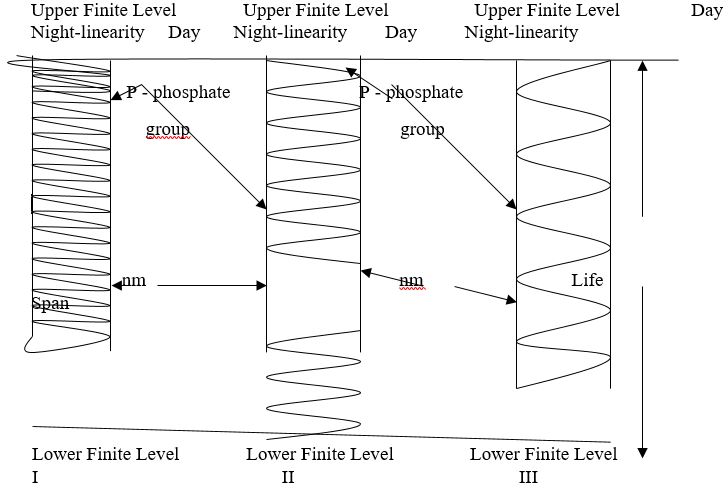
1. There is a constant magnitude of the same chromosome throughout all life stages.
2. There is a broadening trend in nm between two adjacent spirals with age progress.
3. There are P = phosphate groups accountable for day- and nighttime chronology.
This table shows that it is quite plausible that there is a circadian equilibrium algorithmic control (CEAC) continually regulating cells size and composition. At early stages and adulthood, the CEAC leads a positive coefficient, whereas for old age-related cells size and composition it holds a negative coefficient to tune the life span.
Table 2. presents a schematic double helix on the same chromosome across life span.
The crossing line shows a Circadian synchronization for all diploid DNA
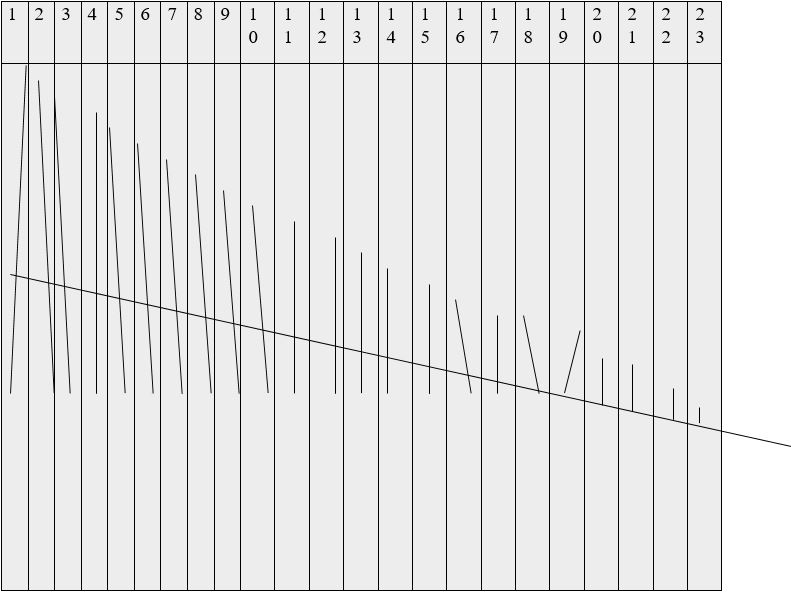
1. Each of the 23 haploid chromosomes have a dissimilar magnitude of spirals.
2. Any Circadian cycle synchronizes an accorded number of spirals on each DNA.
3. Different cells have a variety of biochemical genes tuning the same Circadian cycles.
III. Patterns of encoding mental neuronal networks (MNN) to improve human intelligence and optimizing human survival is shown on table 3 and 4.

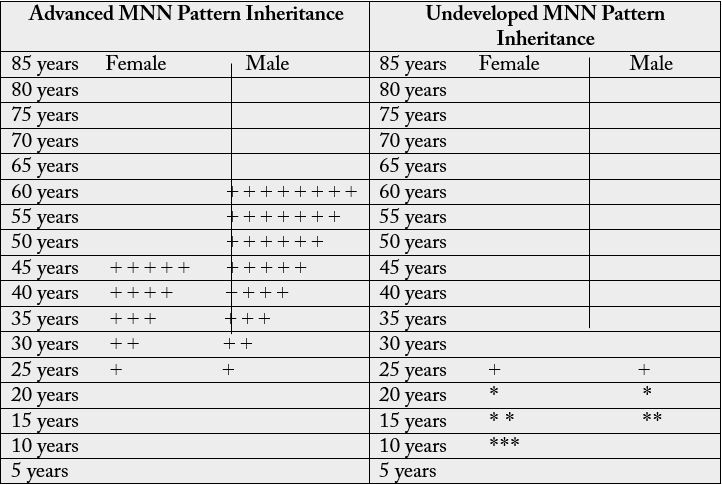
Table 3 indicates that outer objects and life events are placed on new ion channels to be reduced in sizes and encoded on protein genetic templates and accorded deoxyribose sugar backbone in a binary-like trend to be inherit by mature gametes and transferred to posterity after fertilization.
Table 4. shows that the number of ion channels pathways across mental neuronal networks (MNN) advance human progress in comparison with other biological species:
1. A systematic intelligent (academic and practical) gain of new knowledge to be registered on corresponded genetic MNN templates is transferred to given mature gametes at the moment of their impregnation. The older such females or males are the best systematic MNN webs they transfer to the next generation.
Contrary to it, is the early or late adolescence pregnancy. They lack new systematic intelligent knowledge and hence, copy their own undeveloped intelligent MNN pattern to the next generation. The younger the person is in bond for fertilization the worse the inherited undeveloped MNN patterns are.
2. Cloning of ‘sheep Dolly’ and her early aging and death prove that the biophysical neurophysiological aspect of encoding was disregarded in science to be presented on table 5.
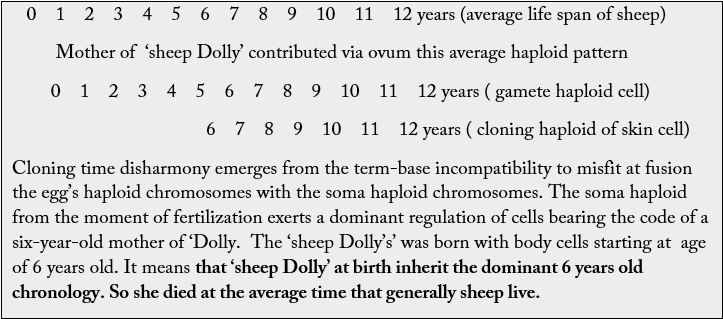
Table 5 demonstrates that in case of ‘sheep Dolly’ we will always have a chronological mismatch by cloning a haploid egg with a somatic haploid set of chromosomes.
3. Organs composing of biochemical elements hold diversify biophysical contours to be presented in table 6.
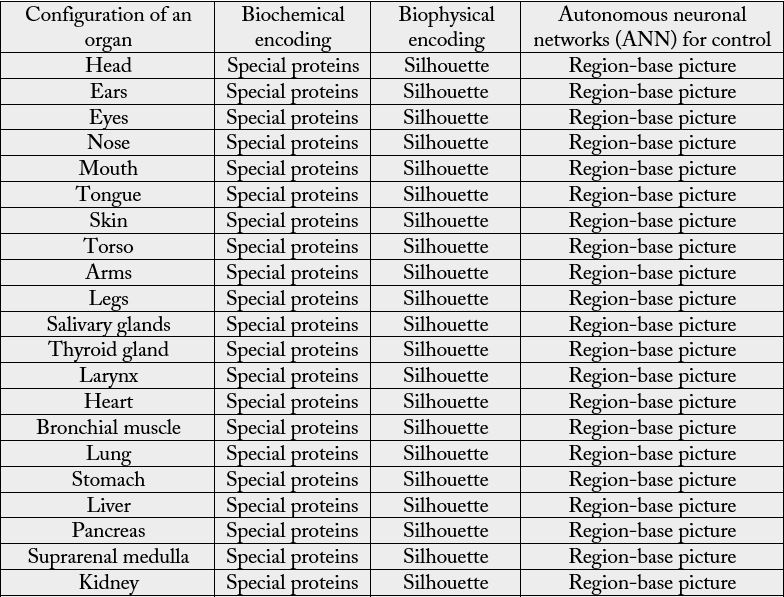
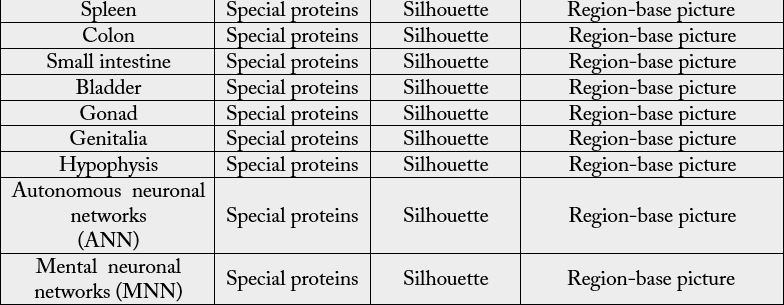
VI. Human self-serving tissues having different biochemical & biophysical encoding to be presented in table 7.
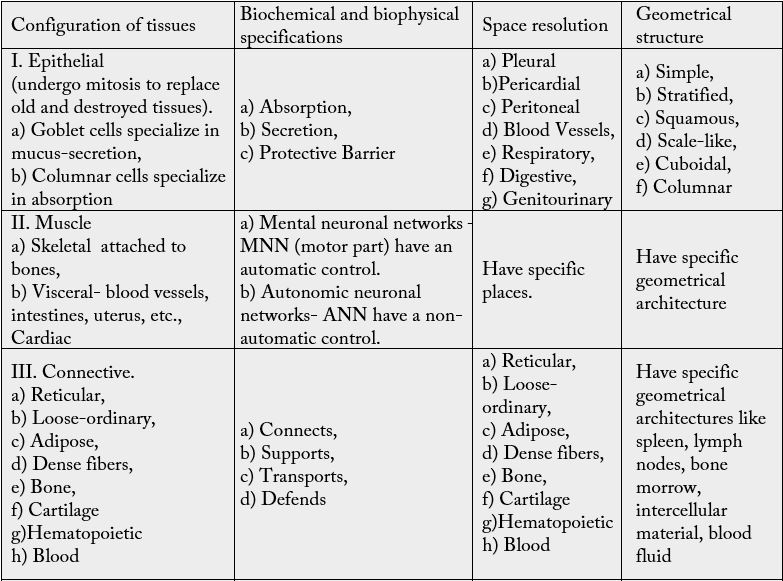
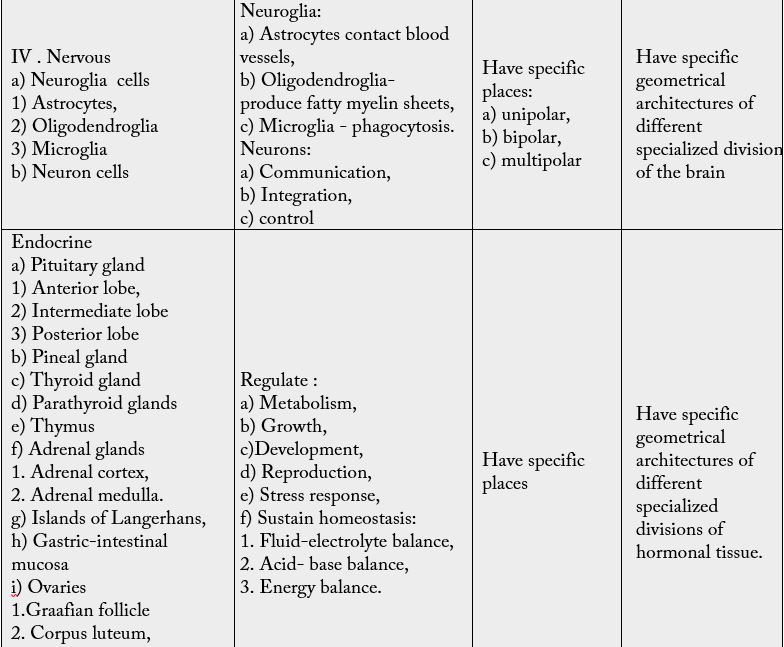

4. Thus, the Human Genome Project failed to highlight the above events.
Modeling Biophysical Neurophysiological Encoding
It is likely to consider that a predefined number of:
1. phosphate groups orderly spiraling in rows from the onset to the end of a double helix are accountable for temporal resolution in regard to circadian and annual growth and developmental stages binding life span frames of reference. It is known that all haploid chromosomes are uneven in sizes. It means that they have an identical compact construction to contain a dissimilar number of spirals accountable for corresponded biochemical and biophysical chronological encoding. This indicates that an equal number of spirals are activated across each of the Circadian cycles in regard to all chromosomes in synchronic operation. This is demonstrated on table 8 and Table 9.
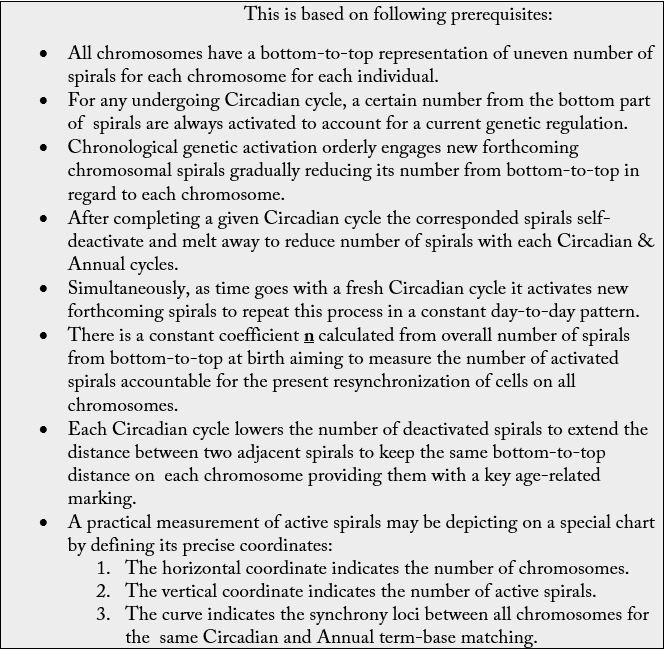
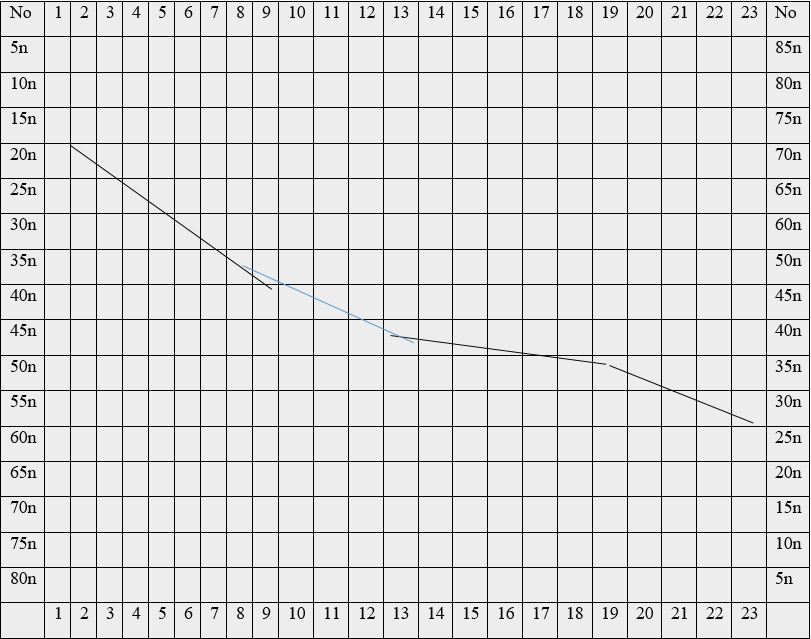
2. elevations and pits placed on As, Gs, Cs Ts genetic templates linked with the given structural pentose sugar (deoxyribose strands) orderly spiraling in rows from the onset to the end of a double helix is accountable for spatial resolution of given organs schemata in regard to circadian and annual growth and developmental stages for human life span frames of reference.
3. heights and pits placed on As, Gs, Cs Ts genetic templates linked with the given structural pentose sugar (deoxyribose strands) orderly spiraling in rows from the onset to the end of a double helix is accountable for given inherited negative feedback programming resolution in regard to circadian /annual growth & developmental stages for human life span.
4. heights and pits placed on As, Gs, Cs Ts genetic templates linked with the given structural pentose sugar deoxyribose) orderly spiraling in rows from the onset to the end of a double helix is accountable for given acquired life event programming on new neuronal electric pathways (NEP’s) the net of which is imprinted on mature gametes to pass on these patterns to the next generation promoting human intelligence at birth resolution in regard to circadian & annual developments.
Nano Technology to Practice Detection of Biophysical Markers
Some principal outlines must include the development of nanometer tools for:
1. In vivo mapping coordinates of mature gametes to identify the activated and deactivated portions in
operation.
2. In vivo mapping out activated spirals from birth and annual to categorize its number for each circadian
cycle in relation to each chronological year.
3. In vivo measuring the nanometer (nm) distance between two adjacent spirals to mark the specific
characteristics applicable to age-related chronology.
4. Detecting As, Gs, Cs, and Ts heights and pits of genetic templates with accorded deoxyribose spirals
bearing different negative feedback mechanisms mechanically encoded on binary-like presentations.
5. Detecting deoxyribose templates bearing different imprinting of advanced mental webs on proper mental
neurons encoded on binary-like pits and heights.
6. Calculating the overall number of spirals accountable for an annual and life span regulation and resolution.
7. Calculating the number of spirals that bear abnormal deregulatory mechanisms predisposing to agerelated
onset of Cancer, Parkinson’s, Alzheimer’s and other diseases when tuned with morbid phenotype
expressions.
8. Non-invasively correcting the deregulatory mechanisms by keeping the organism under full circadian and
annual rhythmic homeostatic frames of reference.
9. In order to develop a chronological fit one must completely avoid “like a sheep dolly” cloning including
organ transplantation.
Conclusion
So, how and in which way can we explain the existing continual ‘turning on’ process across all organs and
systems to operate with similar biochemical and biophysical neurophysiological mechanisms for thousands
of years? For this reason, we need heavily to rely on the human genome project, anatomy, physiology,
biochemistry, biophysics, computer-analog encoding and ecological evolution to understand the human
intelligent advancement in survival and adaptation.
This article shows that the Watson-Crick double helix models after solar circadian and annual cycles in which activated in sequences spirals chronologically self-synchronize the cellular and body growth and development across all life stages:
I. Phosphate groups spirals copy timing of the diurnal and nocturnal synchronic regulation modeling the solar circadian chronology to resynchronize at once all DNA biochemical units guided by the proper activated spirals of the double helix.
Ia. Phosphate group spirals encode in nm widths the number of activated spirals are too accountable for Circadian and Annual changes for the elongated life span.
II. Genetic As, Gs, Cs, Ts tied with the given deoxyribose sugar spirals may use physical binary imprinting in a form of pits and heights to encode the overall complex of negative feedback programs resynchronizing:
IIa. At automatic sleep stage IV the ongoing cellular sizes and homeostasis for individual adaptation and
survival.
IIb. At REM sleep sex organs to optimize at day best pair selections for species survival.
IIc. At daytime, the body operating ranges (BOR) meet adaptation and survival needs.
IId. Structurally for the construction of new mental resumes it is necessary and tangible to expose to a longterm
measured research program that deals with changes in systematic learning and brain mapping. Because
this kind of reasoning is supported by much scientific evidence, large-scale biophysical research is needed to
identify these biophysical neurophysiological signs in order to improve the hereditary system.
Bibliography

Hi!
We're here to answer your questions!
Send us a message via Whatsapp, and we'll reply the moment we're available!